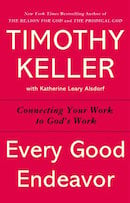Best Books for Business: I Beg to Differ
Blog / Produced by The High Calling
Many years ago, I heard the theory of entropy applied to relationships. Their quality has a tendency to decline over time, this person said. Without effort, couples (and coworkers) may find themselves wondering how they ever got along. The idea stuck and inspired me to tend my marriage well, because I wanted it to not only last, but to always be a source of joy and mutual satisfaction.
In I Beg to Differ: Navigating Difficult Conversations With Truth and Love, Biola University communications professor Tim Muehlhoff offers strong ballast for resisting relational decline.
I began reading the book in search of tips for my work helping to facilitate dialogue between scientists and religious leaders. I quickly discovered, however, that it is chock-full of good advice for marriage and career.
My husband and I have always had good communication, in part because of our mutual love and shared values, and in part because we’ve never let disagreements simmer for too long. There’s been a lot of good will built up between us over nearly 30 years together.
The last several years have depleted some of that good will as health, vocational, and financial challenges, along with grief over our son’s death have taken a toll and changed us both in ways we couldn’t have anticipated.
We sometimes find ourselves talking past each other, making uncharacteristic assumptions about the other person’s thoughts or motives, and generally misunderstanding each other. We’ve turned into squabblers, I’m afraid.
As I've absorbed principles from I Beg to Differ, I’ve found myself stepping back and reflecting on the words that come out of my mouth, sometimes before I speak them and sometimes before a conversation careens too far off course.
“The first step in crafting a difficult conversation is to reclaim a healthy respect for the power of words,” Muehlfoff writes. “As soon as two people start to talk, a communication climate is formed that is just as real as the weather outside your door—and just as impossible to ignore. A key step to improving communication and reducing conflict is to understand the overall climate of the relationship in which the communication takes place."
This climate is a product of how each of us was raised and of our shared relational history. It is “the overarching sense of value and satisfaction individuals feel as they interact with each other and go about daily activities.”
When I communicate annoyance and impatience with my husband because of his physical limitations, it creates an emotionally unsafe environment for him. When he communicates insecurity about the changes he sees in me, it creates a climate of fear in which a healthy relationship cannot flourish.
“We impart life by reminding those with whom we struggle of unchanging truths—I am committed to you as a spouse, you are my daughter, we are both committed to this organization—as we seek to resolve differences and obey biblical commands to pursue peace," Muehlhoff says.
Trust is foundational to good communication.
"To notice and engage another person as a unique and irreplaceable individual is a deeply encouraging form of interaction," Muehlhoff writes. "Conversely, if we regularly feel that our perspective is not being acknowledged in a relationship, the climate will quickly deteriorate."
What about areas of sincere disagreement? "Most conflict begins with a latency period in which tensions exist but go unexpressed," Muehlhoff says. The result can be a verbal explosion in which every perceived offense, no matter how old, gets dragged up.
“Before every conversation, we must manage and recognize our emotions, knowing that they will to some degree be transferred to the other person," he says. This is important because our conflict resolution strategies usually get abandoned once the temperature of the conversation begins to rise.
Muehlhoff suggests having specific goals for difficult conversations:
- Topic goals: "What do we want?"
- Process goals: "How will the conversation be structured?"
- Identity or face-saving goals: "Who am I in this interaction?"
- Relational goals: "Who are we to each other?"
- The nonnegotiable, biblically mandated goal of gentleness.
We should also keep four questions in mind:
- What does the other person believe?
- Why do they believe it?
- Where do we agree?
- Finally, and perhaps most importantly, "With this person, at this time, under these circumstances, what is the next thing I should say?”
There are some dos and don'ts, including:
- Do resist the urge to persuade or correct early in the conversation.
- Listen to understand, not as manipulative strategy.
One danger in this approach is in never getting around to the underlying issues.
“Over time we become experts at finding areas of agreement or common ground while skillfully avoiding areas of contention … We are hesitant to jeopardize the positive climate by challenging others," Muehlhoff says.
"It is a mistake to consistently avoid hard issues. Honesty communicates trust … If the time never seems right to address honest disagreements, then we have fallen into this common mistake," he writes.
At the other end of the spectrum, “If every conversation we have with others is about the issues that divide us, the intensity will hurt the communication climate.”
We need to make time and space for honest disagreement, but also for ordinary interactions and plain old fun.
For my husband and me, this usually means dinner and a short walk or a bike ride. Sometimes there is squabbling. I’m always glad when there’s not.
I can write about our communication challenges because I'm confident we'll work through them, just as we have worked through every other challenge we've faced. We’re both committed to the relationship and are operating in good faith.
This isn't true of all relationships, especially not professional ones.
“Attempting to find common ground with others is a two-way proposition and, unfortunately, we can be rebuffed," Muehlhoff rightly notes.
When we are, there's no reason we can't continue operating with these principles in mind. We have the power to influence the communication climates in our homes and workplaces, no matter how others choose to act.
______________________________
Best Books for Business
As the saying goes, “So many books, so little time.” We all love a good book list. The stacks of books on our nightstands threaten to reach the ceiling, and we are constantly combing yard sales and thrift stores for a bargain on a bookshelf to store all our treasures. Which books are your favorite? And, if you had to narrow down that list to your favorite books for business, which titles would we find there? We asked a few writers to share their recommendations with us, and we thought we’d share their suggestions here with you, in this series, Best Books for Business. See if any of your favorites make an appearance here.
Featured image by Marty Hadding. Used with Permission. Source via Flickr.





